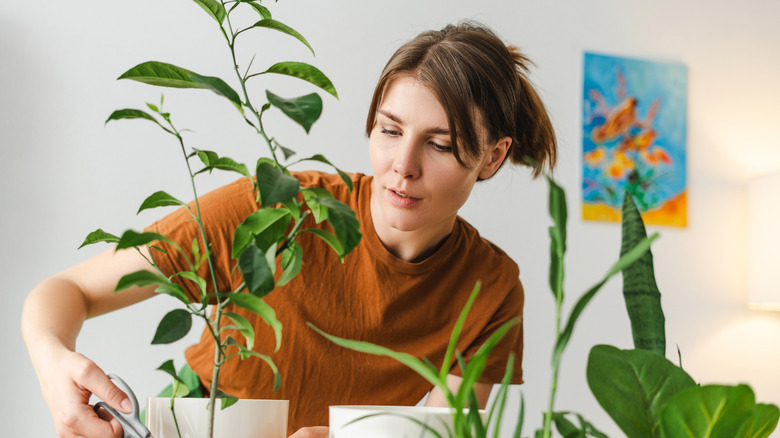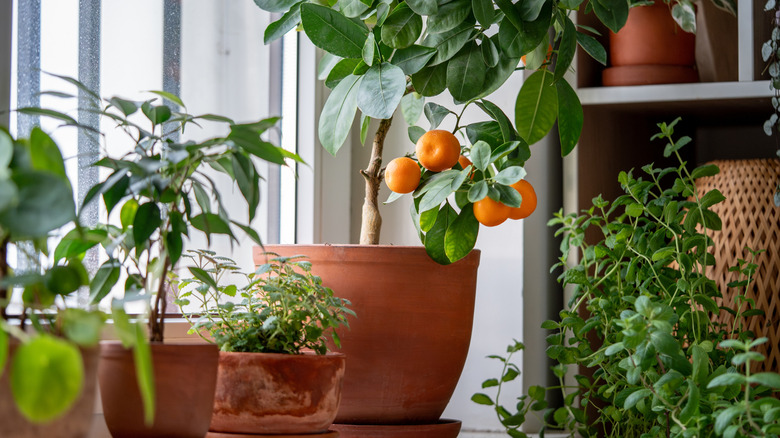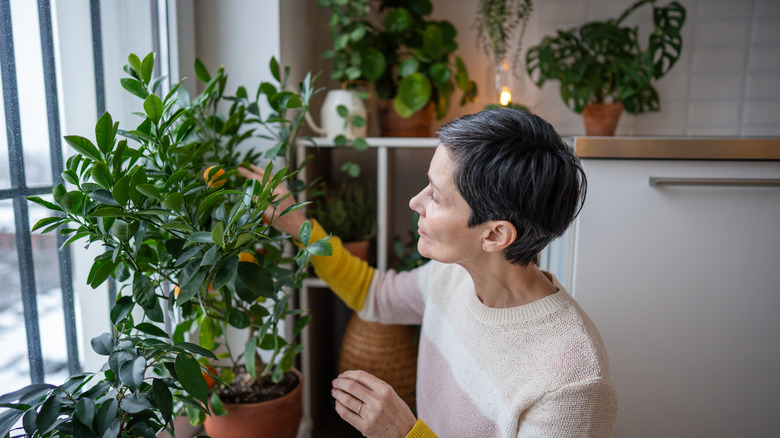For The Best Chance Of Success, This Is The Type Of Fruit Tree You Should Grow Indoors
For many homeowners, the idea of plucking fresh fruit straight from a tree is reserved for warm climates or spacious backyards. Cold winters, compact apartments, and unpredictable weather can make outdoor fruit production a massive challenge. But that doesn't mean you need to give up on your dream of fresh, homegrown harvests. Indoor gardening has opened doors for homeowners who lack the right climate or outdoor space, offering an opportunity to grow thriving fruit trees in containers. The trick is choosing wisely. Not every tree easily adapts to indoor conditions, but citrus trees, especially the dwarf varieties, have become a reliable solution for growers who want success without constant frustration.
Dwarf lemons, limes, and oranges are specially bred to remain small enough for container life while still producing full-sized, flavorful fruit. Their compact size makes them ideal for living rooms, kitchens, or sunrooms, where they can serve both decorative and functional purposes. The glossy foliage brings lush greenery indoors, while their blossoms release a sweet fragrance that rivals even the most expensive candles. Citrus doesn't always require multiple trees for pollination, meaning a single plant can deliver blossoms and fruit. You're rewarded more quickly, and you don't sacrifice taste or appearance in the process. When provided with proper care, these little trees not only produce bright, delicious harvests but have the power to transform entire rooms into miniature orchards. For anyone who is serious about maximizing success, citrus is the fruit tree that combines beauty, practicality, and dependable results in one compact package.
Growing citrus trees indoors
Once you've chosen your desired dwarf citrus tree, success depends on creating the ideal growing environment indoors. Citrus thrives in sunlight, requiring at least eight to twelve hours a day. A south-facing window should provide enough sunlight, but the right supplemental grow light can help your plants thrive when natural light is limited. Use a container with excellent drainage, since soggy soil tends to lead to root rot. A lightweight potting mix designed for citrus or acid-loving plants will keep the roots healthy and well-nourished. When watering, you'll want to aim for a bit of consistency: water deeply when the top two inches of soil are dry, but avoid overwatering, which can stress the plant. Sudden extremes, such as swinging between drought and saturation, are harmful and often lead to yellow leaves or stunted growth.
Beyond watering and light, humidity plays a crucial role in citrus success. Dry indoor air, especially in winter, can cause leaves to curl or drop prematurely. Combat this with a homemade pebble tray, humidifier, or regular misting. Fertilizing with a citrus-specific blend every three to four weeks during the growing season provides essential nutrients for blossoms and fruit. Pruning is another essential step to keep your indoor trees thriving. It can help the plants maintain an attractive appearance while also improving airflow, which reduces the risk of pests like spider mites or scale. Regularly wipe dust from the leaves so that they can absorb the maximum amount of light. Over time, this level of patience will pay off: citrus often flowers within a year or two and can produce fruit steadily once it has been established. The colorful fruit and vibrant green foliage are unmatched by most other houseplants.
Other types of trees that can grow indoors
While citrus trees might be the clear frontrunners when it comes to fruit-bearing trees, adventurous gardeners have been known to try growing other plants indoors. Apples, cherries, pears, figs, or even pineapples can all be grown indoors under the right conditions, although they can be more finicky than citrus. An apple tree can feel whimsical, cherries provide stunning blossoms, figs bring a Mediterranean charm, and pineapples make for a fun, tropical experiment.
However, these trees often present challenges that make them less rewarding for beginner gardeners. Many, including apples and cherries, require cross-pollination from a second tree, which is impractical indoors. Other plants, like pears, can take years before producing fruit, leaving impatient gardeners disappointed. Even figs, which adapt relatively well to containers, still need consistent warmth, strong light, and pruning to remain manageable.
Pineapples also take up significant space and often need two years to produce a single fruit. For gardeners seeking reliable harvests, these obstacles can feel entirely discouraging. While it is possible to succeed with these plants, it requires commitment, experimentation, and a lot of patience. Yields will often be smaller, timelines longer, and conditions stricter. By comparison, citrus offers quicker gratification and less complication, making it far more suitable for most people. For gardeners who enjoy a challenge, experimenting with these alternative trees can be rewarding. Imagine the pride of harvesting a home-grown fig in the winter or the conversations sparked by a pineapple growing near your window. These trees may never rival citrus in dependability, but they add uniqueness and variety to any indoor garden.


